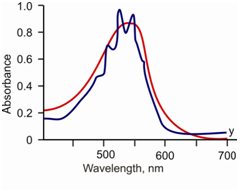Qualitative Applications:
Within terms of qualitative analysis of the analyte, the UV-VIS spectrometry is of a secondary significance for the identification and the determination of structural details. The information acquired from it requirement to be supplemented through that from IR, NMR and mass spectrometries. This is since of easy and broad nature of the spectra. However, it could still give information about the presence or absence and the nature of the chromophore in the molecule. For instance, the presence of one or more signals in the 200-400 nm region of the spectrum is a clear implies of the presence of unsaturation in the molecule.
By lack of fine structure in the UV-visible spectrum does not permits unambiguous identification of the molecule, thus far sometimes the spectrum could be quite useful in distinguishing two molecules having same color. For example, in the above figure gives the visible spectra of two purple colored species of distinctly various structures. One of the spectra happens to be of an azo dye and the other is of permanganate solution. The shapes of the absorption curves help in distinguishing; the smooth curve along with a single maximum is for the dye.

Figure: Absorption spectra of two distinctly different compounds but with similar colour